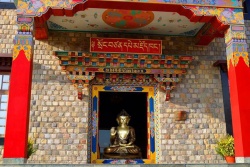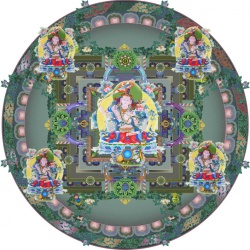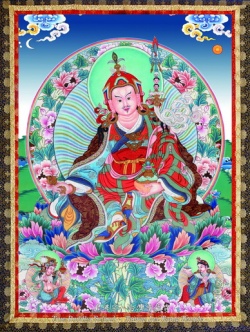Difference between revisions of "Kinnara"
(Created page with "thumb|250px| '''Kinnara'''; A winged celestial being residing in the paradise realms. {{R}} [http://universaldharma.com/2012/k-esoteric-glossary/ universaldh...") |
|||
| (12 intermediate revisions by 2 users not shown) | |||
| Line 1: | Line 1: | ||
| − | [[File: | + | [[File:Kinnon_Wat_Phra_Kaew_02.jpg|thumb|250px|Statue of a kinnara in [[Wat Phra Kaew]], {{Wiki|Bangkok}} ([[Thailand]]).]] |
| − | '''Kinnara'''; A winged celestial being residing in the paradise realms. | + | |
| + | In [[Buddhist mythology]] and [[Hindu]] [[mythology]], a [[kinnara]] is a paradigmatic lover, a [[celestial musician]], half-human and half-horse ([[India]]) or half-bird (south-east {{Wiki|Asia}}). Their [[character]] is clarified in the Adi parva of the [[Mahabharata]], where they say: | ||
| + | |||
| + | :We are everlasting lover and beloved. We never separate. We are eternally husband and wife; never do we become mother and father. No offspring is seen in our lap. We are lover and beloved ever-embracing. In between us we do not permit any third creature demanding {{Wiki|affection}}. Our [[life]] is a [[life]] of [[perpetual]] [[pleasure]]. | ||
| + | |||
| + | They are also featured in a number of [[Buddhist texts]], including the [[Lotus Sutra]]. An {{Wiki|ancient Indian}} string instrument is known as the [[Kinnari]] [[Veena]]. | ||
| + | |||
| + | In [[Southeast]] {{Wiki|Asian}} [[mythology]], [[Kinnaris]], the {{Wiki|female}} counterpart of [[Kinnaras]], are depicted as half-bird, half-woman creatures. One of the many creatures that inhabit the [[mythical]] [[Himavanta]]. [[Kinnaris]] have the head, torso, and arms of a woman and the wings, tail and feet of a {{Wiki|swan}}. She is renowned for her dance, song and [[poetry]], and is a [[traditional]] [[symbol]] of {{Wiki|feminine}} [[beauty]], grace and [[accomplishment]]. | ||
| + | |||
| + | ==Nomenclature, {{Wiki|orthography}} and {{Wiki|etymology}}== | ||
| + | |||
| + | '[[shang-shang]]' ([[Tibetan]]: {{BigTibetan|[[ཤང་ཤང]]}}, [[Wylie]]: [[shang shang]]); ([[Sanskrit]]: [[civacivaka]]); ([[Japanese]]: [[緊那羅]] [[Kinnara]]) | ||
| + | |||
| + | ==[[Burma]]== | ||
| + | [[File:Flag_of_Kayah_State.png|left|thumb|250px|]][[File:Shan_peacock_dance.jpg|thumb|250px|Shan kinnara and kinnari dance]] | ||
| + | In [[Burma]] ([[Myanmar]]), [[kinnara]] are called [[keinnaya]] or [[kinnaya]] (ကိန္နရာ [kèɪɴnəjà]). {{Wiki|Female}} [[kinnara]] are called [[keinnayi]] or [[kinnayi]] (ကိန္နရီ [kèɪɴnəjì]). In Shan, they are ၵိင်ႇၼရႃႇ (Shan pronunciation: [kìŋ kǎ ràː]) and ၵိင်ႇၼရီႇ (Shan pronunciation: [kìŋ nǎ rì]) respectively. [[Burmese]] [[Buddhists]] believe that out of the 136 {{Wiki|past}} [[animal]] [[lives]] of [[Buddha]], four were [[Kinnara]]. The [[kinnari]] is also one of the [[108]] [[symbols]] on the footprint of [[Buddha]]. In [[Burmese]] [[art]], [[kinnari]] are depicted with covered breasts. The [[Myanmar]] {{Wiki|Academy}} Awards statue for {{Wiki|Academy}} Award winners is of a [[kinnari]]. The [[kinnara]] and [[kinnari]] couple is considered the [[symbol]] of the Karenni [[people]]. | ||
| + | |||
| + | ==[[Cambodia]]== | ||
| + | |||
| + | In [[Cambodia]], the [[kinnaras]] are known in the {{Wiki|Khmer}} [[language]] as [[kenar]] (កិន្នរ, កិន្នរា; IPA: [kaːeˈnɑː] or IPA: [kenˈnɑraː]). The {{Wiki|female}} counterpart, the [[kinnari]] (កិន្នរី; IPA: [kenˈnɑrej]), are depicted in Cambodian [[art]] and {{Wiki|literature}} more often than the {{Wiki|male}} counterparts. They are commonly seen as support figurines for the columns of post-Angkorian architecture. They are considered a [[symbol]] of [[beauty]] and are [[skilled]] dancers. The [[kinnari]] is a [[character]] {{Wiki|archetype}} in the repertoire of the {{Wiki|Royal}} Ballet of [[Cambodia]], appearing as mischievous groups that have a strong allurement. A classical dance titled robam kinar depicts [[kinnaris]] playing in a [[lotus]] pond. | ||
| + | |||
| + | ==[[India]]== | ||
| + | |||
| + | [[Kinnaras]] are one of the exotic tribes of {{Wiki|Ancient India}} mentioned along with [[Devas]] (including [[Rudras]], {{Wiki|Maruts}}, [[Vasus]] and [[Adityas]]), [[Asuras]] (including [[Daityas]], [[Danavas]] and [[Kalakeyas]]), Pisachas, [[Gandharvas]], [[Kimpurushas]], [[Vanaras]], [[Suparnas]], [[Rakshasas]], [[Bhutas]] and [[Yakshas]]. They along with others, were inhabitants of the [[Himalaya]] [[mountains]]. The [[people]] of the Gangetic Plain looked upon them with wonder and considered them as super-human. | ||
| + | |||
| + | In particular, the [[word]] [[Kinnara]] (literally means "what [[human]]?" in [[Sanskrit]]) is related to the [[word]] [[Kimpurusha]] (meaning "what man?" i.e. {{Wiki|hermaphrodite}}, half man-half woman). {{Wiki|Legends}} have it that the original [[Kinnaras]] were the troops of Ila, the unfortunate [[King]] who was [[transformed]] into a woman by means of a curse. Later he/she became a wife of the [[divine]] [[hermit]] and [[god]] of the {{Wiki|planet}} {{Wiki|Mercury}}, [[Budha]], while his former soldiers were turned into [[kinnara]] by the [[hermit]] [[Budha]]. | ||
| + | |||
| + | [[Kinnaras]] were mysteriously linked with [[horses]]. {{Wiki|Puranas}} mention them as [[horse-headed beings]]. {{Wiki|Puranas}} mention about an [[Asura]] with a [[horse]] head, who was known as [[Hayagreeva]] (which in [[Sanskrit]] means the [[horse]] headed one; Haya = [[horse]] and greeva = head) This [[Asura]] was killed by an [[incarnation]] of [[Lord]] [[Vishnu]], who took the similar [[form]] of a [[horse-headed]] [[human]] figure. | ||
| + | |||
| + | The {{Wiki|epic}} [[Mahabharata]] mentions [[Kinnaras]], not as [[horse-headed beings]] but as [[beings]] who were half-man and half-horse i.e. like a Centaur. [[Mahabharata]] and the {{Wiki|Puranas}} describe regions [[north]] to [[Himalayas]] as the abode of [[Kinnaras]]. Another reference in the {{Wiki|epic}} considers them as a sub-group of [[Gandharvas]]. | ||
| + | |||
| + | =={{Wiki|Indonesia}}== | ||
| + | [[File:Kalpataru,_Kinnara-Kinnari,_Apsara-Devata,_Pawon_Temple.jpg|thumb|250px|Kinnara (male), Kinnari (female), [[Apsara]], and {{Wiki|Devata}} guarding {{Wiki|Kalpataru}}, the [[divine]] [[tree of life]]. 8th century [[Pawon]] [[temple]], {{Wiki|Java}}, {{Wiki|Indonesia}}.]] | ||
| + | The images of coupled [[Kinnara]] and [[Kinnari]] can be found in [[Borobudur]], Mendut, Pawon, [[Sewu]], Sari, and [[Prambanan]] [[temples]]. Usually, they are depicted as birds with [[human]] heads, or [[humans]] with lower limbs of birds. The pair of [[Kinnara]] and [[Kinnari]] usually is depicted guarding Kalpataru, the [[tree of life]], and sometimes guarding a jar of [[treasure]]. A pair of [[Kinnara]]-[[Kinnari]] bas-reliefs of Sari [[temple]] is unique, depicting [[Kinnara]] as [[celestial]] [[humans]] with birds' wings [[attached]] to their backs, very similar to popular image of {{Wiki|angels}}. | ||
| + | |||
| + | There are bas-relief in [[Borobudur]] depicting the story of the famous [[kinnari]], [[Manohara]]. | ||
| + | |||
| + | ==[[Thailand]]== | ||
| + | [[File:Kinnari_at_Phra_Meru_of_HRH_Princess_Galyani_Vadhana.jpg|thumb|left|250px|Sculpture of a kinnari which was decorated in the royal crematorium of Princess {{Wiki|Galyani Vadhana}} at {{Wiki|Sanam Luang}}, {{Wiki|Bangkok}}, {{Wiki|Thailand}} (2008).]] | ||
| + | The [[Kinnari]], (usually spelt '[[Kinnaree]]' as noted below) ([[Thai]]: กินรี) in [[Thai]] {{Wiki|literature}} originates from [[India]], but was modified to fit in with the [[Thai]] way of [[thinking]]. The [[Thai]] [[Kinnari]] is depicted as a young woman wearing an angel-like costume. The lower part of the [[body]] is similar to a bird, and should enable her to fly between the [[human]] and the [[mystical]] [[worlds]]. | ||
| + | |||
| + | The most famous [[Kinnari]] in [[Thailand]] is the figure known as [[Manora]] (derived from [[Manohara]]), a [[Wikipedia:Hero|heroine]] in one of the stories collected in "[[Pannas Jataka]]" a [[Pali]] tome written by a Chiangmai [[Buddhist monk]] and [[Wikipedia:Sage (sophos|sage]] around AD 1450-1470. This is supposed to be a collection of 50 stories of the {{Wiki|past}} [[lives]] of the [[Buddha]], known to [[Buddhists]] as the [[Jataka]]. The specific tale about [[Manora]] the [[Kinnaree]] was called [[Sudhana Jataka]], after {{Wiki|Prince}} [[Sudhana]], the [[bodhisattva]] who was also the [[hero]] of the story and the husband of [[Manora]]. | ||
| + | |||
| + | It has been speculated that the stories of Manora/Manohara told in {{Wiki|Southeast Asia}} might related to the stories of the Cowherd and the [[Celestial]] Weaver Girl, popular in [[China]], [[Japan]] and [[Korea]]. | ||
| + | |||
| + | The story inspired a dance called Manorah Buchayan, which is one of the most [[esoteric]] among the high classical dances of [[Thailand]], as well as the "Norah" dance of southern [[Thailand]]. | ||
| + | |||
| + | [[Thai]] Airways International publishes a monthly magazine with the title [[Kinnaree]]. | ||
| + | |||
| + | The {{Wiki|male}} counterpart of the {{Wiki|female}} [[Kinnari]] is a [[Kinnon]] ([[Thai]]: กินนร). | ||
| + | |||
| + | ==[[Tibet]]== | ||
| + | |||
| + | In [[Tibet]] the [[Kinnara]] is known as the '[[shang-shang]]' ([[Tibetan]]: {{BigTibetan|ཤང་ཤང}}, [[Wylie]]: [[shang shang]]) ([[Sanskrit]]: [[civacivaka]]). This chimera is depicted either with just the head or including the whole torso of a [[human]] including the arms with the lower [[body]] as that of a winged bird. In [[Nyingma]] [[Mantrayana]] [[traditions]] of [[Mahayoga]] [[Buddhadharma]], the [[shang-shang]] [[symbolizes]] '[[enlightened activity]]' ([[Wylie]]: [[phrin las]]). The [[shang-shang]] is a [[celestial]] [[musician]] and is often iconographically depicted with [[cymbals]]. A homonymic play on words is evident which is a marker of oral lore: the '[[shang]]' ([[Tibetan]]: {{BigTibetan|[[གཆང]]}}, [[Wylie]]: [[gchang]]) is a [[cymbal]] or [[gong]] like [[ritual]] instrument in the indigenous [[traditions]] of the [[Himalaya]]. The [[shang-shang]] is sometimes depicted as the [[king]] of the [[Garuda]]. | ||
| + | {{DisplayImages|1981|1398|3016|3751}} | ||
| + | {{W}} | ||
| + | {{NewSourceBreak}} | ||
| + | [[Kinnara]]; A winged [[celestial]] {{Wiki|being}} residing in the [[paradise]] [[realms]]. | ||
| + | |||
{{R}} | {{R}} | ||
[http://universaldharma.com/2012/k-esoteric-glossary/ universaldharma.com] | [http://universaldharma.com/2012/k-esoteric-glossary/ universaldharma.com] | ||
| − | [[ | + | {{NewSourceBreak}} |
| − | [[Category: | + | '''[[Kinnara]]''' (Skt.; Tib. {{BigTibetan|[[མིའམ་ཅི་]]}}, ''[[mi'amchi]]''; [[Wyl.]] ''[[mi'm ci]]'') — one of the [[eight classes of gods and demons]]; they are slightly similar to [[human beings]] in their [[appearance]]. |
| + | |||
| + | {{RigpaWiki}} | ||
| + | {{NewSourceBreak}} | ||
| + | [[kinnaras]]: One of the eight types of [[celestial beings]]. [[Horse-headed celestial musicians]] having a human-like [[body]]. Their [[king]] is [[Lord]] [[Vaishravana]]. | ||
| + | |||
| + | {{R}} | ||
| + | [http://xuanfa.net/glossary/k/ xuanfa.net] | ||
| + | {{NewSourceBreak}} | ||
| + | |||
| + | [[Kinnara]], [[Kinnari]] [[Religious]] Significance Kinggala The [[Kinnari]] is a half-bird half-female [[demigod]] in Buddhist/Hindu [[Mythology]] who resides in the [[Himalayas]] | ||
| + | |||
| + | The [[Kinnara]] is her {{Wiki|male}} counterpart | ||
| + | |||
| + | The [[Kinnari]] has the head, torso, and arms of a woman and the wings, tail, and feet of a bird Her bird half enables her to quickly navigate between [[earthly]] and [[mythical]] [[worlds]] She is well known for her dance, song and [[poetry]], and is a [[traditional]] [[symbol]] of {{Wiki|feminine}} [[beauty]], grace and [[accomplishment]] [[Kinnari]] figures appear in [[Burmese]], Cambodian, [[Indian]], {{Wiki|Indonesian}}, [[Thai]] and [[Tibetan]] [[Hindu]] and [[Buddhist]] [[myths]] ([[thought]] to have originated in preshistoric [[India]]) | ||
| + | |||
| + | {{R}} | ||
| + | [http://prezi.com/qxod54bfxfvm/copy-of-kinnara-kinnari/ prezi.com] | ||
| + | {{NewSourceBreak}} | ||
| + | |||
| + | [[kimnara]]<br/> [[緊那羅]] (Skt; Jpn [[kinnara]] ) Also, [[kinnara]]. According to {{Wiki|Indian mythology}}, musicians of the [[deity]] [[Kuvera]] who excel in singing and [[dancing]] and have a [[human body]] and the head of a [[horse]]. They were regarded as the [[gods]] of [[music]]. In [[Buddhism]], they are one of the eight kinds of [[nonhuman beings]] who {{Wiki|protect}} the [[Buddha's teachings]], as are the [[heavenly musicians]] called [[gandharvas]]. | ||
| + | |||
| + | {{R}} | ||
| + | [http://www.sgilibrary.org/search_dict.php?id=1191 sgilibrary.org] | ||
| + | {{NewSourceBreak}} | ||
| + | |||
| + | The [[Burmese]] [[Mythological]] birds known as [[Kinnara]] and [[Kinaree]] are two [[mythological]] half bird half [[human]] figures and a [[symbol]] of the Karenni states, they represent the [[symbol]] of true [[love]]. These half [[human]] and half bird creatures and play a part also in [[Hindu]] [[mythology]], they are mentioned in several [[Buddhist texts]]. The [[Burmese]] believe that in some of the {{Wiki|past}} [[animal]] [[lives]] of [[Buddha]] four of them were [[kinnara]]. They are also depicted in Cambodian, [[Tibetan]], {{Wiki|Indonesian}} and [[Thai]] {{Wiki|literature}} and [[art]] with slightly different versions of pronunciations such as [[Kenar]], [[kinnara]], [[keinnaya]] or [[kinnaya]], (the {{Wiki|female}}), [[kinnaree]], [[kinari]] (the {{Wiki|male}}). | ||
| + | |||
| + | In [[Thailand]] there are many dances depicting these two half [[human]] half bird [[kinnaris]]. | ||
| + | |||
| + | |||
| + | [[Category:Kimnara's]] | ||
Latest revision as of 08:04, 8 July 2014
In Buddhist mythology and Hindu mythology, a kinnara is a paradigmatic lover, a celestial musician, half-human and half-horse (India) or half-bird (south-east Asia). Their character is clarified in the Adi parva of the Mahabharata, where they say:
- We are everlasting lover and beloved. We never separate. We are eternally husband and wife; never do we become mother and father. No offspring is seen in our lap. We are lover and beloved ever-embracing. In between us we do not permit any third creature demanding affection. Our life is a life of perpetual pleasure.
They are also featured in a number of Buddhist texts, including the Lotus Sutra. An ancient Indian string instrument is known as the Kinnari Veena.
In Southeast Asian mythology, Kinnaris, the female counterpart of Kinnaras, are depicted as half-bird, half-woman creatures. One of the many creatures that inhabit the mythical Himavanta. Kinnaris have the head, torso, and arms of a woman and the wings, tail and feet of a swan. She is renowned for her dance, song and poetry, and is a traditional symbol of feminine beauty, grace and accomplishment.
Nomenclature, orthography and etymology
'shang-shang' (Tibetan: ཤང་ཤང, Wylie: shang shang); (Sanskrit: civacivaka); (Japanese: 緊那羅 Kinnara)
Burma
In Burma (Myanmar), kinnara are called keinnaya or kinnaya (ကိန္နရာ [kèɪɴnəjà]). Female kinnara are called keinnayi or kinnayi (ကိန္နရီ [kèɪɴnəjì]). In Shan, they are ၵိင်ႇၼရႃႇ (Shan pronunciation: [kìŋ kǎ ràː]) and ၵိင်ႇၼရီႇ (Shan pronunciation: [kìŋ nǎ rì]) respectively. Burmese Buddhists believe that out of the 136 past animal lives of Buddha, four were Kinnara. The kinnari is also one of the 108 symbols on the footprint of Buddha. In Burmese art, kinnari are depicted with covered breasts. The Myanmar Academy Awards statue for Academy Award winners is of a kinnari. The kinnara and kinnari couple is considered the symbol of the Karenni people.
Cambodia
In Cambodia, the kinnaras are known in the Khmer language as kenar (កិន្នរ, កិន្នរា; IPA: [kaːeˈnɑː] or IPA: [kenˈnɑraː]). The female counterpart, the kinnari (កិន្នរី; IPA: [kenˈnɑrej]), are depicted in Cambodian art and literature more often than the male counterparts. They are commonly seen as support figurines for the columns of post-Angkorian architecture. They are considered a symbol of beauty and are skilled dancers. The kinnari is a character archetype in the repertoire of the Royal Ballet of Cambodia, appearing as mischievous groups that have a strong allurement. A classical dance titled robam kinar depicts kinnaris playing in a lotus pond.
India
Kinnaras are one of the exotic tribes of Ancient India mentioned along with Devas (including Rudras, Maruts, Vasus and Adityas), Asuras (including Daityas, Danavas and Kalakeyas), Pisachas, Gandharvas, Kimpurushas, Vanaras, Suparnas, Rakshasas, Bhutas and Yakshas. They along with others, were inhabitants of the Himalaya mountains. The people of the Gangetic Plain looked upon them with wonder and considered them as super-human.
In particular, the word Kinnara (literally means "what human?" in Sanskrit) is related to the word Kimpurusha (meaning "what man?" i.e. hermaphrodite, half man-half woman). Legends have it that the original Kinnaras were the troops of Ila, the unfortunate King who was transformed into a woman by means of a curse. Later he/she became a wife of the divine hermit and god of the planet Mercury, Budha, while his former soldiers were turned into kinnara by the hermit Budha.
Kinnaras were mysteriously linked with horses. Puranas mention them as horse-headed beings. Puranas mention about an Asura with a horse head, who was known as Hayagreeva (which in Sanskrit means the horse headed one; Haya = horse and greeva = head) This Asura was killed by an incarnation of Lord Vishnu, who took the similar form of a horse-headed human figure.
The epic Mahabharata mentions Kinnaras, not as horse-headed beings but as beings who were half-man and half-horse i.e. like a Centaur. Mahabharata and the Puranas describe regions north to Himalayas as the abode of Kinnaras. Another reference in the epic considers them as a sub-group of Gandharvas.
Indonesia
The images of coupled Kinnara and Kinnari can be found in Borobudur, Mendut, Pawon, Sewu, Sari, and Prambanan temples. Usually, they are depicted as birds with human heads, or humans with lower limbs of birds. The pair of Kinnara and Kinnari usually is depicted guarding Kalpataru, the tree of life, and sometimes guarding a jar of treasure. A pair of Kinnara-Kinnari bas-reliefs of Sari temple is unique, depicting Kinnara as celestial humans with birds' wings attached to their backs, very similar to popular image of angels.
There are bas-relief in Borobudur depicting the story of the famous kinnari, Manohara.
Thailand

The Kinnari, (usually spelt 'Kinnaree' as noted below) (Thai: กินรี) in Thai literature originates from India, but was modified to fit in with the Thai way of thinking. The Thai Kinnari is depicted as a young woman wearing an angel-like costume. The lower part of the body is similar to a bird, and should enable her to fly between the human and the mystical worlds.
The most famous Kinnari in Thailand is the figure known as Manora (derived from Manohara), a heroine in one of the stories collected in "Pannas Jataka" a Pali tome written by a Chiangmai Buddhist monk and sage around AD 1450-1470. This is supposed to be a collection of 50 stories of the past lives of the Buddha, known to Buddhists as the Jataka. The specific tale about Manora the Kinnaree was called Sudhana Jataka, after Prince Sudhana, the bodhisattva who was also the hero of the story and the husband of Manora.
It has been speculated that the stories of Manora/Manohara told in Southeast Asia might related to the stories of the Cowherd and the Celestial Weaver Girl, popular in China, Japan and Korea.
The story inspired a dance called Manorah Buchayan, which is one of the most esoteric among the high classical dances of Thailand, as well as the "Norah" dance of southern Thailand.
Thai Airways International publishes a monthly magazine with the title Kinnaree.
The male counterpart of the female Kinnari is a Kinnon (Thai: กินนร).
Tibet
In Tibet the Kinnara is known as the 'shang-shang' (Tibetan: ཤང་ཤང, Wylie: shang shang) (Sanskrit: civacivaka). This chimera is depicted either with just the head or including the whole torso of a human including the arms with the lower body as that of a winged bird. In Nyingma Mantrayana traditions of Mahayoga Buddhadharma, the shang-shang symbolizes 'enlightened activity' (Wylie: phrin las). The shang-shang is a celestial musician and is often iconographically depicted with cymbals. A homonymic play on words is evident which is a marker of oral lore: the 'shang' (Tibetan: གཆང, Wylie: gchang) is a cymbal or gong like ritual instrument in the indigenous traditions of the Himalaya. The shang-shang is sometimes depicted as the king of the Garuda.
Source
Kinnara; A winged celestial being residing in the paradise realms.
Source
Kinnara (Skt.; Tib. མིའམ་ཅི་, mi'amchi; Wyl. mi'm ci) — one of the eight classes of gods and demons; they are slightly similar to human beings in their appearance.
Source
kinnaras: One of the eight types of celestial beings. Horse-headed celestial musicians having a human-like body. Their king is Lord Vaishravana.
Source
Kinnara, Kinnari Religious Significance Kinggala The Kinnari is a half-bird half-female demigod in Buddhist/Hindu Mythology who resides in the Himalayas
The Kinnara is her male counterpart
The Kinnari has the head, torso, and arms of a woman and the wings, tail, and feet of a bird Her bird half enables her to quickly navigate between earthly and mythical worlds She is well known for her dance, song and poetry, and is a traditional symbol of feminine beauty, grace and accomplishment Kinnari figures appear in Burmese, Cambodian, Indian, Indonesian, Thai and Tibetan Hindu and Buddhist myths (thought to have originated in preshistoric India)
Source
kimnara
緊那羅 (Skt; Jpn kinnara ) Also, kinnara. According to Indian mythology, musicians of the deity Kuvera who excel in singing and dancing and have a human body and the head of a horse. They were regarded as the gods of music. In Buddhism, they are one of the eight kinds of nonhuman beings who protect the Buddha's teachings, as are the heavenly musicians called gandharvas.
Source
The Burmese Mythological birds known as Kinnara and Kinaree are two mythological half bird half human figures and a symbol of the Karenni states, they represent the symbol of true love. These half human and half bird creatures and play a part also in Hindu mythology, they are mentioned in several Buddhist texts. The Burmese believe that in some of the past animal lives of Buddha four of them were kinnara. They are also depicted in Cambodian, Tibetan, Indonesian and Thai literature and art with slightly different versions of pronunciations such as Kenar, kinnara, keinnaya or kinnaya, (the female), kinnaree, kinari (the male).
In Thailand there are many dances depicting these two half human half bird kinnaris.







